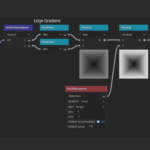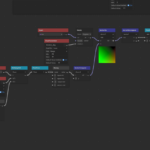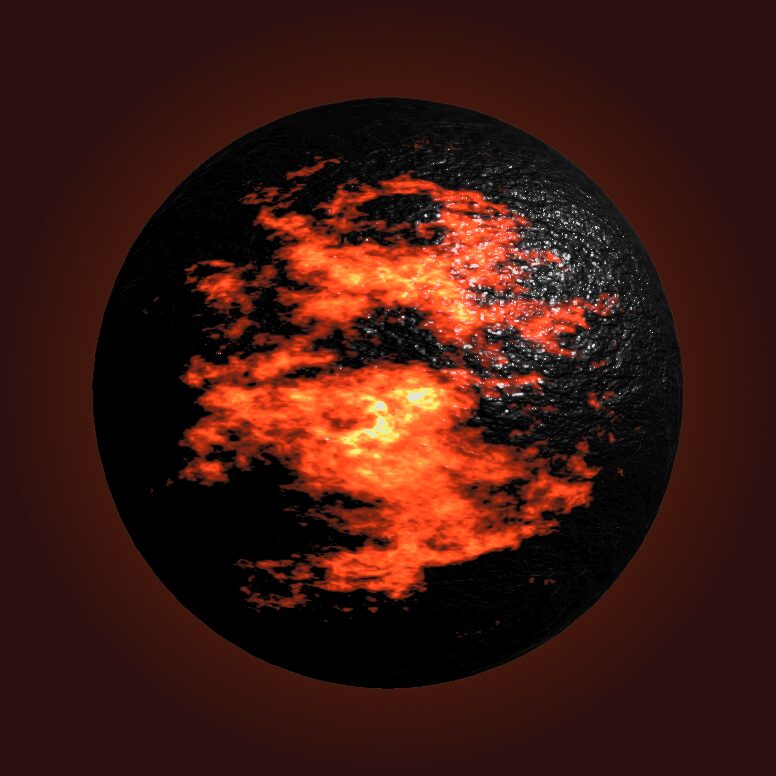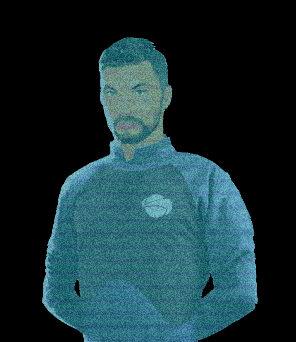Highlight CanvasItem
Highlight effect as a CanvasItem Material
How to use:
- Place a node of a control type (i.e. TextureRect/Button);
- Create a ColorRect child;
- In the Inspector under CanvasItem panel apply the material and select Highlight shader;
- If needed change Clip Children property of the parent node to Clip+Draw (Inspector -> CanvasItem -> Visibility -> Clip Children);
- If experience the change of parent node’s color change the blending mode of either the highlight shader (line 2 of shader code) or the parent node’s material, pick a combination that works for you.
Parameters:
- Line Smoothness – makes the highlight edges softer, 0 = hard edges;
- Line Width – makes line thiner/wider, 0 = thin line;
- Brightness – multiplicative parameter, that makes the line more visible, diffirent combinations of Line Smoothness, Line Width and Brightness produces various results;
- Rotation Deg – rotates the highlight, incrementing the value rotates the highlight clockwise;
- Distortion – merges line with the edges of the ColorRect (see ColorRect in How to use section);
- Speed – dictates how fast the effect is moving from one side to the opposite;
- Position – manual placement of the highlight line, 0 = Position Min, 1 = Position Max;
- Position Min – starting point of the highlight line;
- Position Max – end point of the highlight line;
- Alpha – controls the overall visibility of the highlight;
- Color is controlled by the object itself, change the color property of the ColorRect to change the highlight, if the shader is applyed to the texture element, then the texture will be clipped by the highlight
I initially made this shader in VisualShader editor and refactored the code to publish here, the screenshots include the nodes setup. The shader uses Rotate node from ShaderLib library by iDigvijaysinhG. It is not necessary to install the library to use the shader.
Shader code
shader_type canvas_item;
render_mode blend_premul_alpha;
uniform float Line_Smoothness : hint_range(0, 0.1) = 0.045;
uniform float Line_Width : hint_range(0, 0.2) = 0.09;
uniform float Brightness = 3.0;
uniform float Rotation_deg : hint_range(-90, 90) = 30;
uniform float Distortion : hint_range(1, 2) = 1.8;
uniform float Speed = 0.7;
uniform float Position : hint_range(0, 1) = 0;
uniform float Position_Min = 0.25;
uniform float Position_Max = 0.5;
uniform float Alpha : hint_range(0, 1) = 1;
vec2 rotate_uv(vec2 uv, vec2 center, float rotation, bool use_degrees){
float _angle = rotation;
if(use_degrees){
_angle = rotation * (3.1415926/180.0);
}
mat2 _rotation = mat2(
vec2(cos(_angle), -sin(_angle)),
vec2(sin(_angle), cos(_angle))
);
vec2 _delta = uv - center;
_delta = _rotation * _delta;
return _delta + center;
}
void fragment() {
vec2 center_uv = UV - vec2(0.5, 0.5);
float gradient_to_edge = max(abs(center_uv.x), abs(center_uv.y));
gradient_to_edge = gradient_to_edge * Distortion;
gradient_to_edge = 1.0 - gradient_to_edge;
vec2 rotaded_uv = rotate_uv(UV, vec2(0.5, 0.5), Rotation_deg, true);
float remapped_position;
{
float output_range = Position_Max - Position_Min;
remapped_position = Position_Min + output_range * Position;
}
float remapped_time = TIME * Speed + remapped_position;
remapped_time = fract(remapped_time);
{
float output_range = 2.0 - (-2.0);
remapped_time = -2.0 + output_range * remapped_time;
}
vec2 offset_uv = vec2(rotaded_uv.xy) + vec2(remapped_time, 0.0);
float line = vec3(offset_uv, 0.0).x;
line = abs(line);
line = gradient_to_edge * line;
line = sqrt(line);
float line_smoothness = clamp(Line_Smoothness, 0.001, 1.0);
float offset_plus = Line_Width + line_smoothness;
float offset_minus = Line_Width - line_smoothness;
float remapped_line;
{
float input_range = offset_minus - offset_plus;
remapped_line = (line - offset_plus) / input_range;
}
remapped_line = remapped_line * Brightness;
remapped_line = min(remapped_line, Alpha);
COLOR.rgb = vec3(COLOR.xyz) * vec3(remapped_line);
COLOR.a = remapped_line;
}












I can’t seem to make it work.
“error(43): Built-in function “fma(float, float, float)” is only supported on high-end platforms.”
I tried switching from Compatibility mode to Forward+ and even OpenGL Compatibility and it still doesn’t work because of this error.
(THIS DOESNT WORK, READ THE COMMENT ABOVE)
change that line of code with:
float remapped_time = TIME * Speed + remapped_position;
forget it, that somehow makes the whole sprite/image invert its colors.
HERES WHAT WORKED FOR ME:
shader_type canvas_item;
render_mode blend_mix;
uniform float Line_Smoothness : hint_range(0, 0.1) = 0.045;
uniform float Line_Width : hint_range(0, 0.2) = 0.09;
uniform float Brightness = 3.0;
uniform float Rotation_deg : hint_range(-90, 90) = 30;
uniform float Distortion : hint_range(1, 2) = 1.8;
uniform float Speed = 0.7;
uniform float Position : hint_range(0, 1) = 0;
uniform float Position_Min = 0.25;
uniform float Position_Max = 0.5;
uniform float Alpha : hint_range(0, 1) = 1;
vec2 rotate_uv(vec2 uv, vec2 center, float rotation, bool use_degrees){
float _angle = rotation;
if(use_degrees){
_angle = rotation * (3.1415926/180.0);
}
mat2 _rotation = mat2(
vec2(cos(_angle), -sin(_angle)),
vec2(sin(_angle), cos(_angle))
);
vec2 _delta = uv – center;
_delta = _rotation * _delta;
return _delta + center;
}
void fragment() {
vec2 center_uv = UV – vec2(0.5, 0.5);
float gradient_to_edge = max(abs(center_uv.x), abs(center_uv.y));
gradient_to_edge = gradient_to_edge * Distortion;
gradient_to_edge = 1.0 – gradient_to_edge;
vec2 rotaded_uv = rotate_uv(UV, vec2(0.5, 0.5), Rotation_deg, true);
float remapped_position;
{
float output_range = Position_Max – Position_Min;
remapped_position = Position_Min + output_range * Position;
}
float remapped_time = TIME * Speed + remapped_position;
remapped_time = fract(remapped_time);
{
float output_range = 2.0 – (-2.0);
remapped_time = -2.0 + output_range * remapped_time;
}
vec2 offset_uv = vec2(rotaded_uv.xy) + vec2(remapped_time, 0.0);
float line = vec3(offset_uv, 0.0).x;
line = abs(line);
line = gradient_to_edge * line;
line = sqrt(line);
float line_smoothness = clamp(Line_Smoothness, 0.001, 1.0);
float offset_plus = Line_Width + line_smoothness;
float offset_minus = Line_Width – line_smoothness;
float remapped_line;
{
float input_range = offset_minus – offset_plus;
remapped_line = (line – offset_plus) / input_range;
}
remapped_line = clamp(remapped_line * Brightness, 0.0, 1.0);
remapped_line = min(remapped_line, Alpha);
// Sample the original texture
vec4 original_color = texture(TEXTURE, UV);
// Apply the effect as an additive blend
COLOR = original_color + vec4(remapped_line, remapped_line, remapped_line, 0.0);
COLOR.a = original_color.a;
}
Amazing fix/comment -> tried it and it worked right away for me!!
I updated the shader, the problem in fact lies in the fma function being not available in compatibility mode and should be switched to regular a*b+c, as CrossJ mentioned.
The fma is just a little optimization which is considered a single operation instead of two (first multiply, then addition). I was surprised to know that it’s not available
CrossJ also mentioned that it inverted colors, which is caused by the blending mode being blend_premul_alpha. I set it for the softened edges to be displayed without any artifacts, i put a warning in the howto guide so that users would be aware of blending modes
I’m trying to use this on a sprite but the makes most of the pixels black. Anything i can change to fix that?
You should try changing the blending mode to blend_mix. I updated the howto guide and elaborated on this issue in the comment section
Ill look into it. Thanks!
The only way for me to get proper results was by clamping the end result
remapped_line = clamp(remapped_line,0.0,1.0);COLOR = vec4(remapped_line);COLOR.a = remapped_line;When using Sprite, is it reasonable to ignore the transparent part
Ignore in which way? I don’t quite follow
Blank pixels in the image do not display reflections